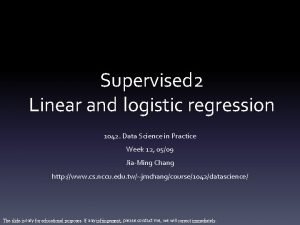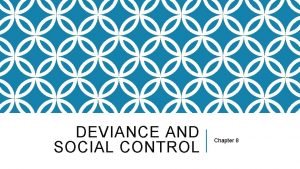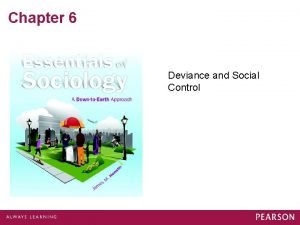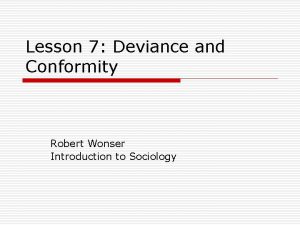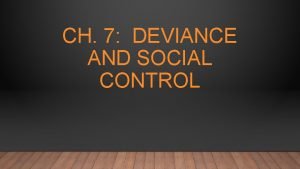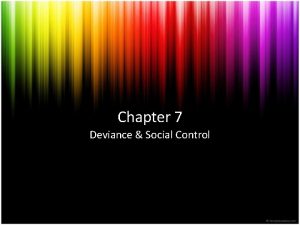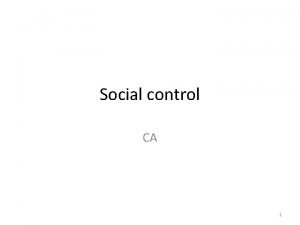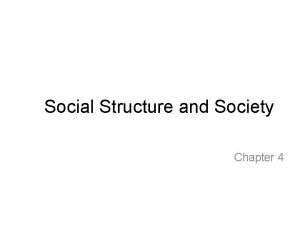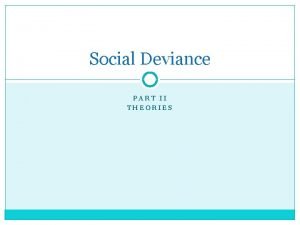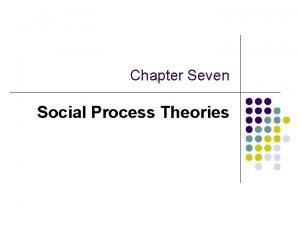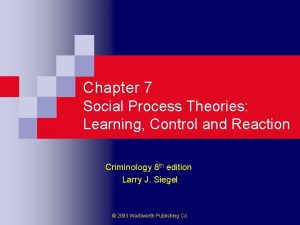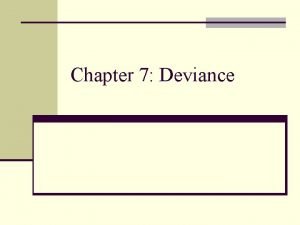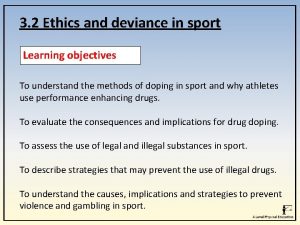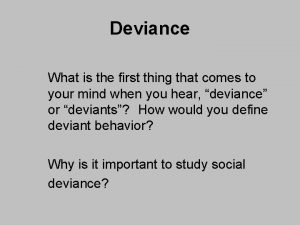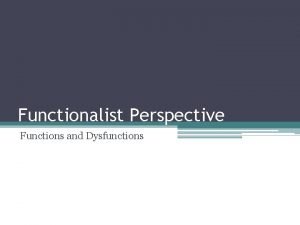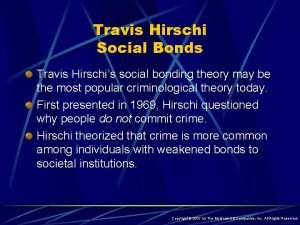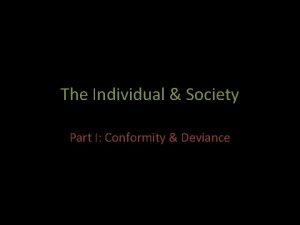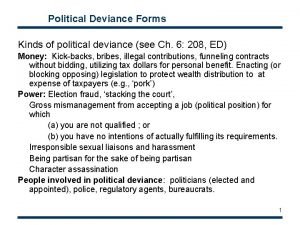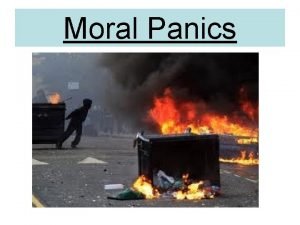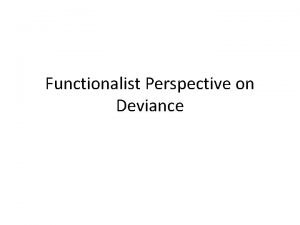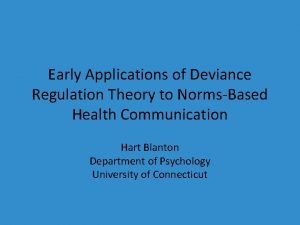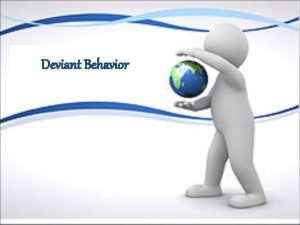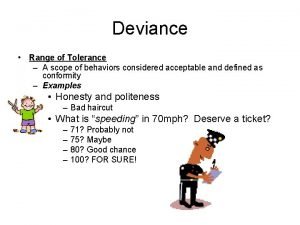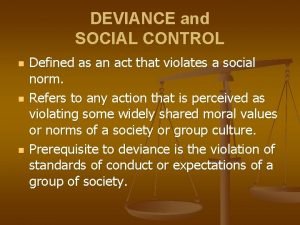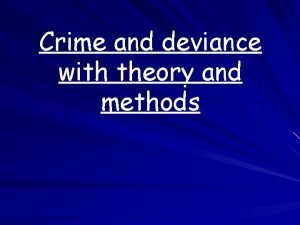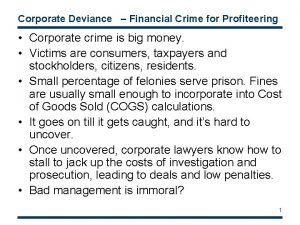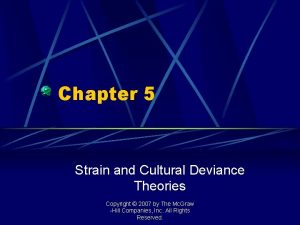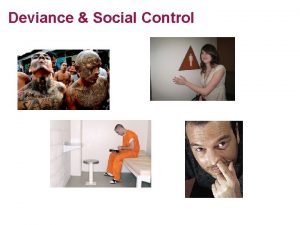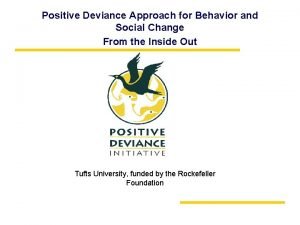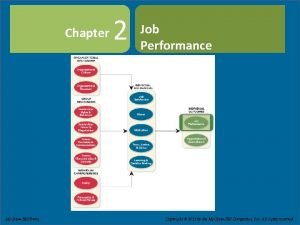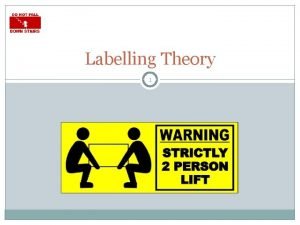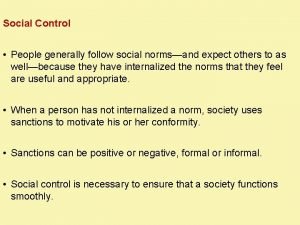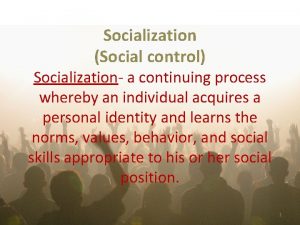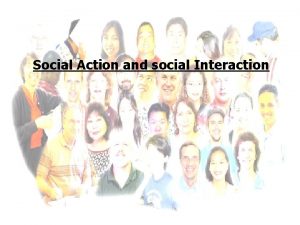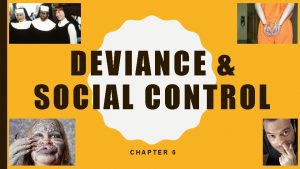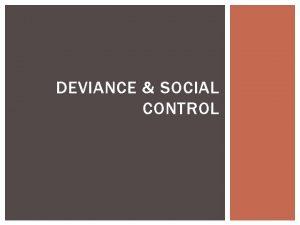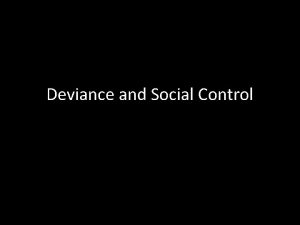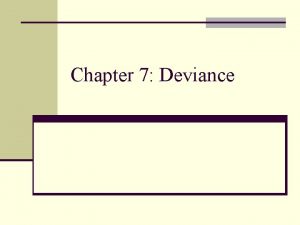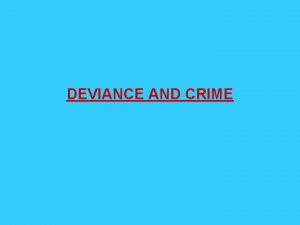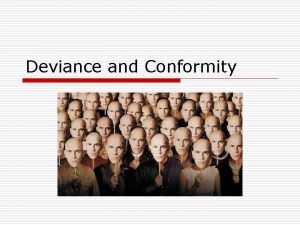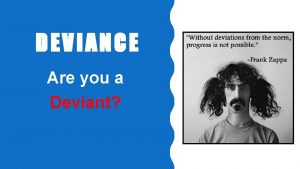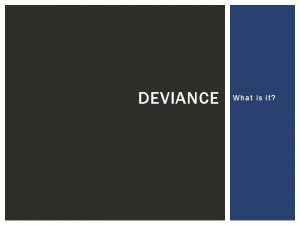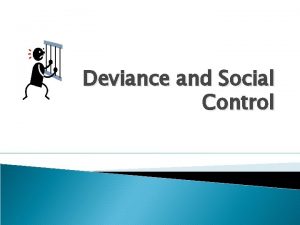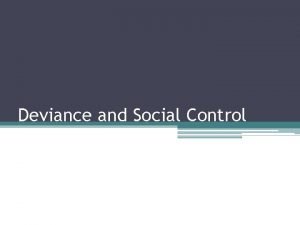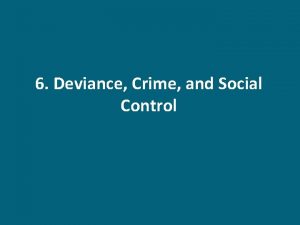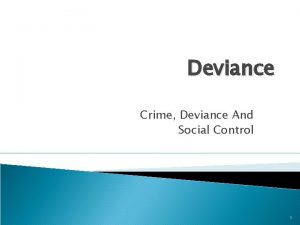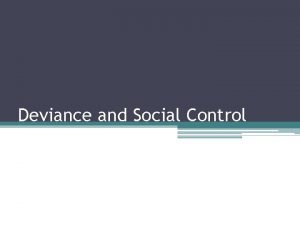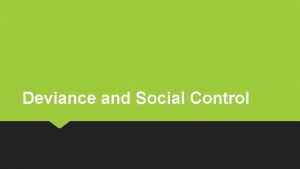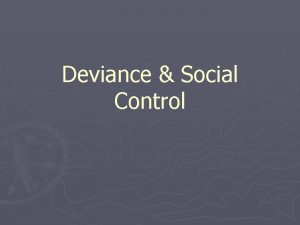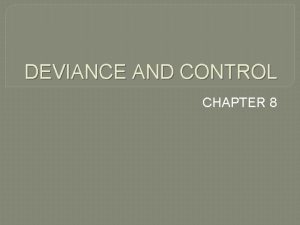Social Control and Deviance Chapter 7 Social Control


















































- Slides: 50

Social Control and Deviance Chapter 7: Social Control and Deviance Case Study: The Saints and the Roughnecks Section 1: Social Control Section 2: Deviance Section 3: Crime Experiment: Applying What You’ve Learned Original Content Copyright © Holt Mc. Dougal. Additions and changes to the original content are the responsibility of the instructor.

Social Control and Deviance Case Study: The Saints and the Roughnecks A 1973 article explored the different views that townspeople held of two teenage gangs, one called the Saints and one called the Roughnecks. The author of the article claimed that even though both gangs were violent, delinquent, and disruptive, townspeople agreed that the gang from the higher social class was not as much trouble as the gang from the lower social class. While objective observation concluded that both gangs were equally destructive, the differing views revealed much about the social preconceptions that were at work in the town. Original Content Copyright © Holt Mc. Dougal. Additions and changes to the original content are the responsibility of the instructor.

Social Control and Deviance Original Content Copyright © Holt Mc. Dougal. Additions and changes to the original content are the responsibility of the instructor.

Social Control and Deviance Section 1 at a Glance Social Control • People generally follow social norms—and expect others to as well—because they have internalized the norms that they feel are useful and appropriate. • When a person has not internalized a norm, society uses sanctions to motivate his or her conformity. • Sanctions can be positive or negative, formal or informal. • Social control is necessary to ensure that a society functions smoothly. Original Content Copyright © Holt Mc. Dougal. Additions and changes to the original content are the responsibility of the instructor.

Social Control and Deviance Social Control Main Idea • Norms must be followed for a society to run smoothly, and they are enforced through internalization and sanctions. Reading Focus • How do social norms become internalized? • What are the differences between positive and negative sanctions and between formal and informal sanctions? • What is social control? Original Content Copyright © Holt Mc. Dougal. Additions and changes to the original content are the responsibility of the instructor.

Social Control and Deviance What if your every misdeed were posted on a Web site? Original Content Copyright © Holt Mc. Dougal. Additions and changes to the original content are the responsibility of the instructor.

Social Control and Deviance Internalization of Norms • Every society has norms that must be upheld to run smoothly. • Internalization is the process by which a norm becomes a part of an individual’s personality, thus conditioning that individual to conform to society’s expectations. • Examples: – Sitting in a chair instead of on the floor – Stopping at a red light Original Content Copyright © Holt Mc. Dougal. Additions and changes to the original content are the responsibility of the instructor.

Social Control and Deviance Reading Check Identify Supporting Details What characteristics describe a norm that is likely to be internalized? Answer: good, useful, and appropriate Original Content Copyright © Holt Mc. Dougal. Additions and changes to the original content are the responsibility of the instructor.

Social Control and Deviance Sanctions Positive sanctions Negative sanctions • Positive sanction: An action that rewards a particular kind of behavior • Negative sanction: A punishment or the threat of punishment used to enforce conformity. • Examples include: a teacher giving good grades, cheers from teammates • Examples include: a parking ticket, ridicule Formal sanctions Informal sanctions • Formal sanction: A reward or punishment given by a formal organization or regulatory agency • Informal sanction: A spontaneous expression of approval or disapproval given by an individual or group • Examples include: schools giving high or low grades, a business giving a raise or firing a worker • Examples include: standing ovations, gossip Original Content Copyright © Holt Mc. Dougal. Additions and changes to the original content are the responsibility of the instructor.

Social Control and Deviance Reading Check Find the Main Idea What is the purpose of sanctions? Answer: to encourage people to follow social norms Original Content Copyright © Holt Mc. Dougal. Additions and changes to the original content are the responsibility of the instructor.

Social Control and Deviance Original Content Copyright © Holt Mc. Dougal. Additions and changes to the original content are the responsibility of the instructor.

Social Control and Deviance Social Control • Social control is enforcing norms through either internal or external means. – Primary means is self-control – Other agents use sanctions • Police, religious figures, family, peer group, and public opinion • Behavior that violates society’s basic norms jeopardizes the social order. Original Content Copyright © Holt Mc. Dougal. Additions and changes to the original content are the responsibility of the instructor.

Social Control and Deviance Reading Check Analyze Why is social control important to society? Answer: for society to function smoothly—social stability Original Content Copyright © Holt Mc. Dougal. Additions and changes to the original content are the responsibility of the instructor.

Social Control and Deviance Current Research in Sociology Death Penalty: The Ultimate Sanction This sanction has been used since ancient times to punish murderers and other criminals. Its morality is debated today. Many nations have banned the death penalty, though the United States still allows it. • Opposition to the death penalty arose during the Enlightenment, which resulted in limiting its use. • Critics claim the practice is immoral and ineffective, and cannot be administered fairly. • Venezuela became the first country to ban the practice. • Support for the death penalty remains strong. • By 2007, two-thirds of nations had banned the practice. Original Content Copyright © Holt Mc. Dougal. Additions and changes to the original content are the responsibility of the instructor.

Social Control and Deviance Original Content Copyright © Holt Mc. Dougal. Additions and changes to the original content are the responsibility of the instructor.

Social Control and Deviance Thinking Critically • What does it mean when a country is considered “abolitionist in practice”? • Why do you think the death penalty is a focus of such debate in the United States? Original Content Copyright © Holt Mc. Dougal. Additions and changes to the original content are the responsibility of the instructor.

Social Control and Deviance Section 2 at a Glance Deviance • Deviance is any behavior that violates significant social norms. • Deviance can serve positive functions, such as clarifying norms, unifying the group, diffusing tension, promoting social change, and providing jobs. • Functionalists, conflict theorists, and interactionists offer different theories to explain deviance. Original Content Copyright © Holt Mc. Dougal. Additions and changes to the original content are the responsibility of the instructor.

Social Control and Deviance Main Idea Deviance, which is behavior that violates social norms, serves a purpose in society. Sociologists have many theories to explain deviant behavior. Reading Focus • How do sociologists identify the nature of deviance? • What are the social functions of deviance? • How do theories that have been proposed to explain deviance compare? Original Content Copyright © Holt Mc. Dougal. Additions and changes to the original content are the responsibility of the instructor.

Social Control and Deviance Why would a teenage boy lock himself in his room and hide from society? Original Content Copyright © Holt Mc. Dougal. Additions and changes to the original content are the responsibility of the instructor.

Social Control and Deviance The Nature of Deviance Behavior that violates significant social norms is called deviance. Violating Norms The Label of Deviance • Some norms deal with fairly insignificant behaviors. • Individuals must be caught committing a deviant act and be stigmatized by society. • Because there are so many norms, occasional violations are unavoidable. • Behaviors deemed deviant differ across times, cultures, and situations. • A stigma is a mark of social disgrace that sets the deviant apart from the rest of society. • Sociologists usually refer to the negative social reactions. Original Content Copyright © Holt Mc. Dougal. Additions and changes to the original content are the responsibility of the instructor.

Social Control and Deviance Reading Check Analyze How does behavior that is considered deviant change based on context? Answer: Some behaviors are considered deviant in some situations and not others, or in one society and not another, or from time period to time period. Original Content Copyright © Holt Mc. Dougal. Additions and changes to the original content are the responsibility of the instructor.

Social Control and Deviance Social Functions of Deviance has some uses in society – Helps to clarify norms, unify the group, diffuse tension, and promote social change – Serves to define the boundaries of acceptable behavior – Punishment of deviance can prevent others from same deviance – Draws lines of society and “outsiders” – Displays of minor deviance diffuse tensions – Provides legitimate jobs such as lawyers and police Original Content Copyright © Holt Mc. Dougal. Additions and changes to the original content are the responsibility of the instructor.

Social Control and Deviance Reading Check Summarize How can deviance benefit society? Answer: It helps to clarify norms, unify the group, diffuse tension, and promote social change. It also creates jobs, defines the boundaries of acceptable behavior, and draws the line between conforming and nonconforming members of society. Original Content Copyright © Holt Mc. Dougal. Additions and changes to the original content are the responsibility of the instructor.

Social Control and Deviance Explaining Deviance The three sociological perspectives explain the causes and uses of deviance. Functionalist Perspective • Strain theory: deviance is the natural outgrowth of the values, norms, and structure of society • Pressure on individuals to meet standards that they can’t meet • Anomie: the norms of society are unclear or no longer apply • Results in confusion over rules for behavior • Five “modes of adaptation, ” or reactions to societal norms • Conformity: acceptance of goals and methods of reaching them • Innovation: acceptance of goals but not means of reaching them • Ritualism: abandon goals but maintain expected behaviors • Retreatism: reject both goals and means of reaching them • Rebellion: seek to substitute new goals and means for existing goals and means Original Content Copyright © Holt Mc. Dougal. Additions and changes to the original content are the responsibility of the instructor.

Social Control and Deviance Original Content Copyright © Holt Mc. Dougal. Additions and changes to the original content are the responsibility of the instructor.

Social Control and Deviance Conflict Perspective • Sees social life as a struggle between the ruling classes and lower classes • Says people commit deviant acts to gain or maintain power • Ruling class deems any behavior that threatens its power as deviant Interactionist Perspective • Three major explanations: control theory, cultural transmission theory, and labeling theory • Control theory: states that deviance is normal and studies why people conform; states that people conform when they have strong ties to the community Original Content Copyright © Holt Mc. Dougal. Additions and changes to the original content are the responsibility of the instructor.

Social Control and Deviance • Cultural transmission theory: states that deviance is a learned behavior; deviants are socialized into deviant behavior instead of acceptable behavior; individuals will adopt the behavior and goals of whomever they are in contact with • Differential association: the relative closeness to deviant and non-deviant individuals • Labeling theory: focuses on how people come to be labeled “deviant; ” suggests there are two types of deviance • Primary deviance: occasional violation of norms; neither self nor society labels person “deviant” • Secondary deviance: deviance as a lifestyle; both self and society label person “deviant” Original Content Copyright © Holt Mc. Dougal. Additions and changes to the original content are the responsibility of the instructor.

Social Control and Deviance Original Content Copyright © Holt Mc. Dougal. Additions and changes to the original content are the responsibility of the instructor.

Social Control and Deviance Reading Check Contrast How do the sociological perspectives view deviance differently? Answer: Some focus on why individuals perform deviant acts, and others focus on how individuals come to be identified as deviants. Original Content Copyright © Holt Mc. Dougal. Additions and changes to the original content are the responsibility of the instructor.

Social Control and Deviance Section 3 at a Glance Crime • Crime affects everyone in the United States, some as victims, some as criminals, and some as observers. • Crimes are grouped into five general categories: violent crime, property crime, victimless crime, white-collar crime, and organized crime. • Crime statistics are gathered and reported by two main sources, the Uniform Crime Reports and the National Crime Victimization Survey. • The criminal-justice system—made up of the police, the courts, and corrections—deals with crimes that have been committed and reported. Original Content Copyright © Holt Mc. Dougal. Additions and changes to the original content are the responsibility of the instructor.

Social Control and Deviance Crime Main Idea There are several different types of crimes. The U. S. criminal-justice system investigates, prosecutes, and punishes criminals. Reading Focus • What are crimes, and who commits them? • What are the principal types of crime in the United States? • How are crime statistics gathered and reported? • What are the characteristics of the criminal-justice system? Original Content Copyright © Holt Mc. Dougal. Additions and changes to the original content are the responsibility of the instructor.

Social Control and Deviance How does the definition of crime change with time and circumstance? Original Content Copyright © Holt Mc. Dougal. Additions and changes to the original content are the responsibility of the instructor.

Social Control and Deviance Crime and Criminals • A crime is any act that is labeled as such by those in authority and is prohibited by law. • An act that is immoral is not necessarily illegal. • Criminals can be any age, gender, or race, although people under 35 are more likely to be involved in crime. Original Content Copyright © Holt Mc. Dougal. Additions and changes to the original content are the responsibility of the instructor.

Social Control and Deviance Reading Check Find the Main Idea What criteria are used to determine if an act is criminal? Answer: the act is labeled a crime by those in authority and is prohibited by law Original Content Copyright © Holt Mc. Dougal. Additions and changes to the original content are the responsibility of the instructor.

Social Control and Deviance Types of Crime Violent Crime • Murder, forcible rape, robbery, and aggravated assault • Make up small percentage of total crime rates, but still alarming • One every 22 seconds in the United States • Most victims are African Americans • Majority of murders committed with guns Property Crime • Burglary, larceny, motor vehicle theft, and arson • One every three seconds in the United States • People under 25 commit most crimes • Many crimes committed by those on drugs Original Content Copyright © Holt Mc. Dougal. Additions and changes to the original content are the responsibility of the instructor.

Social Control and Deviance Victimless Crime • Prostitution, illegal gambling, illegal drug use, and vagrancy • Although classified as “victimless, ” often have negative consequences for society White-Collar Crime • White-collar crimes include fraud, tax evasion, embezzlement, price-fixing, toxic pollution, insider trading, and political corruption • Corporations can be charged with crimes, not just individuals Organized Crime • Crime syndicate: a large-scale organization of professional criminals that controls some vice or legitimate business through violence • Legitimate businesses can serve as “fronts” for illegal activities Original Content Copyright © Holt Mc. Dougal. Additions and changes to the original content are the responsibility of the instructor.

Social Control and Deviance Reading Check Analyze Pick one type of crime and analyze its cost to society. Answer: Possible answer—victimless crime (prostitution): increased spread of contagious diseases such as STDs, increased health care costs due to sexually transmitted diseases, drug use, and violence on the streets. Original Content Copyright © Holt Mc. Dougal. Additions and changes to the original content are the responsibility of the instructor.

Social Control and Deviance Original Content Copyright © Holt Mc. Dougal. Additions and changes to the original content are the responsibility of the instructor.

Social Control and Deviance Crime Statistics • The Uniform Crime Reports (UCR) is published annually by the FBI. – Uses data from local police departments – Factors that limit reporting of crimes: • Not all complaints make it into a formal report. • People less likely to make a report against friend or family member. • Police more likely to make an official report when crime is against a high-status person. • Victims less likely to report some forms of crime. • The National Crime Victimization Survey (NCVS) is published by the Bureau of Justice Statistics. – Uses data from crime victims about reported and unreported crimes – Relies on interviews with representative sample Original Content Copyright © Holt Mc. Dougal. Additions and changes to the original content are the responsibility of the instructor.

Social Control and Deviance Original Content Copyright © Holt Mc. Dougal. Additions and changes to the original content are the responsibility of the instructor.

Social Control and Deviance Reading Check Summarize What circumstances may limit the filing of formal crime reports? Answer: Individuals are less likely to report a crime if family or friends are involved. The police are more likely to file a formal report if the victim is in a higher social class. Original Content Copyright © Holt Mc. Dougal. Additions and changes to the original content are the responsibility of the instructor.

Social Control and Deviance The Criminal-Justice System Police Courts • Control over who is arrested • Police discretion: the ability to decide who is actually arrested • Racial profiling: the practice of assuming that nonwhite Americans are more likely to commit crimes • Hold trials to determine guilt or innocence • If guilty, assign punishments • Plea bargaining: the process of legal negotiation that allows a guilty plea in return for a lighter sentence Corrections Juvenile-Justice System • Corrections: Imprisonment, parole, probation, community service • Functions: retribution, deterrence, rehabilitation, social protection • Recidivism: repeated criminal behavior • Young offenders cannot be expected to be as responsible as adults • New laws ensure juveniles receive fair treatment • Some places treat young as adults Original Content Copyright © Holt Mc. Dougal. Additions and changes to the original content are the responsibility of the instructor.

Social Control and Deviance Click on the image below to play the Interactive. Original Content Copyright © Holt Mc. Dougal. Additions and changes to the original content are the responsibility of the instructor.

Social Control and Deviance Reading Check Summarize What role does each component of the criminal-justice system serve? Answer: police—decide whether to arrest those who commit a crime; courts—determine the guilt or innocence of the accused and assign a punishment; corrections—carry out the punishment Original Content Copyright © Holt Mc. Dougal. Additions and changes to the original content are the responsibility of the instructor.

Social Control and Deviance Sociology in Today’s World Identity Theft Identity theft occurs when a criminal uses another person’s name and financial standing to buy items or complete financial transactions. Victims of identity theft often lose their financial standings because of the crime. • Identity thieves may rent an apartment, get medical services, make large purchases, or use another’s name while being arrested. • Methods of theft include stealing wallets or phishing. • Prevention methods include shredding documents and monitoring bank statements. • Federal Trade Commission estimates there are more than 9 million cases a year. Original Content Copyright © Holt Mc. Dougal. Additions and changes to the original content are the responsibility of the instructor.

Social Control and Deviance Original Content Copyright © Holt Mc. Dougal. Additions and changes to the original content are the responsibility of the instructor.

Social Control and Deviance Thinking Critically • In what category of crime does identity theft belong? • How might the different theoretical perspectives on deviance explain identity theft? Original Content Copyright © Holt Mc. Dougal. Additions and changes to the original content are the responsibility of the instructor.

Social Control and Deviance Experiment: Applying What You’ve Learned How to Be an Ethnomethodologist What role do norms play in your everyday life? 1. Introduction 2. Choosing a Norm • In this experiment, you will examine the norms you have internalized by choosing one to break. • Identify a norm you can break, resulting in unique but harmless behavior that is atypical for you. • Ethnomethodology is the study of how people do things. • Ethnomethodologists deliberately break norms in order to define them. • Once you identify a norm, break it. Observe the people around you. If possible, repeat the experiment in different settings. • Write notes about your experience. Original Content Copyright © Holt Mc. Dougal. Additions and changes to the original content are the responsibility of the instructor.

Social Control and Deviance Experiment (cont. ) 3. Record Your Observations 4. Role-play Your Experience • Using your notes, write a report of your experiment that answers the following questions: • In small groups, create role-playing scripts for one of the group members’ experiment. • What norm did you choose? • Choose a spokesperson to present the skit and describe the possible effects on society if others broke the same norm. • What setting did you choose? • What kind of people witnessed your experiment? • How did people respond? • How did you feel while breaking the norm? Original Content Copyright © Holt Mc. Dougal. Additions and changes to the original content are the responsibility of the instructor.

Social Control and Deviance Experiment (cont. ) 5. Discussion • What did you learn from this experiment? As a group, discuss the following: • Which norm breaking was most interesting? • What emotions did you experience? • Was your behavior seen by an authority figure? • Did you experience any sanctions for your behavior? • Did you think of yourself as deviant? Original Content Copyright © Holt Mc. Dougal. Additions and changes to the original content are the responsibility of the instructor.
 Logistic regression residual deviance
Logistic regression residual deviance Chapter 7 deviance crime and social control
Chapter 7 deviance crime and social control Primary deviance definition
Primary deviance definition Chapter 6 deviance and social control
Chapter 6 deviance and social control Lesson quiz 7-1 deviance and social control
Lesson quiz 7-1 deviance and social control Guided reading activity deviance and social control
Guided reading activity deviance and social control A person who breaks significant societal or group norms
A person who breaks significant societal or group norms Internal and external social control
Internal and external social control Crime and deviance sociology revision
Crime and deviance sociology revision Merton’s typology
Merton’s typology Inner and outer controls work against deviance
Inner and outer controls work against deviance Difference between crime and deviance
Difference between crime and deviance Primary and secondary deviance
Primary and secondary deviance Social process theory
Social process theory Behavior that violates significant social norms is called
Behavior that violates significant social norms is called Deviance in sport
Deviance in sport Primary and secondary deviance examples
Primary and secondary deviance examples Example of informal social control
Example of informal social control Deviance examples
Deviance examples Marxism crime and deviance
Marxism crime and deviance Functions and dysfunctions of deviance
Functions and dysfunctions of deviance Social bond theory criminology
Social bond theory criminology Example of strain theory
Example of strain theory What is political deviance
What is political deviance Deviancy amplification
Deviancy amplification Normalization of deviance ppt
Normalization of deviance ppt Functionalist perspective on deviance
Functionalist perspective on deviance Deviance regulation theory
Deviance regulation theory What is deviance
What is deviance Overconforms
Overconforms Criminal deviance
Criminal deviance Acts of deviance
Acts of deviance Corporate deviance definition
Corporate deviance definition Culture conflict theory
Culture conflict theory What is deviance in sport
What is deviance in sport Discouraging criminal acts by threatening punishment.
Discouraging criminal acts by threatening punishment. Explaining deviance biological perspect
Explaining deviance biological perspect Relative deviance
Relative deviance Positive deviance sociology definition
Positive deviance sociology definition Underconformity
Underconformity The most common form of production deviance is
The most common form of production deviance is Labelling theory lemert
Labelling theory lemert Social thinking and social influence in psychology
Social thinking and social influence in psychology Social thinking social influence social relations
Social thinking social influence social relations Social darwinism paralleled the economic doctrine of
Social darwinism paralleled the economic doctrine of Process control and product control
Process control and product control What is positive and negative control
What is positive and negative control Flow and error control
Flow and error control Enforcing norms through either internal or external means
Enforcing norms through either internal or external means Socialization and social control
Socialization and social control Social action vs social interaction
Social action vs social interaction
